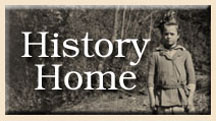

Jennie Nicol Memorial Health Center: Page 2
By the early 1940s, the JNMHC was, thanks to a combination of harsh mountain
weather, termite infestations, and constant use, severely dilapidated and
in need of major repairs. Hoping to influence the Pi Beta Phi Grand Council,
the Settlement School Committee, Alumnae Clubs, and active Pi Phis to make
renovating the clinic a priority, Pi Phi and Settlement School teacher Agnes
Wright Spring described the cottage’s deplorable condition in the March
1943 edition of the Arrow of Pi Beta Phi. “The large rocks near the
doors,” she wrote, “are used to prop the warped doors shut or
open, as desired. . . . The basement is moldy and the foundations are wobbly
from the constant attack of termites.” It would, however, take time
for the fraternity to act, for just as financial difficulties and resources
scarcities arising from the First World War had prevented the Grand Council
and Settlement School Committee from moving on the hospital project in 1914,
the Second World War, and the need to conserve funds, now prevented it from
addressing the needs of the JNMHC. It was not until 1947 that the Settlement
School Committee approved plans for a new JNMHC, to be built on the Gatlinburg
Parkway adjacent to the Arrowcraft Shop. Funding for construction came primarily
in the form of several large donations, and the new hospital was ready for
occupancy in the summer of 1948.
On settling into the new building, nurse Chalmers resumed her regular duties.
There were, after all, still plenty of students to examine, inoculations to
give, and first aid to administer. With the advent of the Cold War, however,
the JNMHC acquired an unexpected new duty: that of serving as a rallying point
for civilians, soldiers, and government employees in the event of a Soviet
nuclear attack. Gatlinburg stood in close proximity to three of the most important
sites in the burgeoning U. S. military-industrial complex: Oak Ridge, Tennessee,
home to numerous nuclear weapons production facilities; Knoxville, Tennessee,
headquarters of the Tennessee Valley Authority; and Alcoa, Tennessee, named
for the sprawling Aluminum Company of America plant that represented its primary
industry, and which provided U. S. defense contractors with much of their
aluminum. And yet, at the same time, the city was situated far enough away
from these potential targets to survive a nuclear attack (or so it was assumed).
How the JNMHC would have responded to such a crisis is, thankfully, unknown;
suffice to say that nurse Chalmers and the settlement school staff would doubtless
have acquitted themselves well.
So it went for the next twenty years: Gatlinburg residents young and old patronized
the JNMHC, and the JNMHC did its best to meet their needs. “Within its
. . . walls,” nurse Chalmers insisted, one encountered “all the
problems of living of the entire [Gatlinburg] community. That will be so as
long as we continue to serve.”
Like all good things, however, the little clinic eventually outlived its usefulness.
In 1950, a certain Dr. Shilling established a full-time medical practice in
Gatlinburg, relieving the JNMHC of much of its patient load. Sevierville hailed
the arrival of a fully-modern hospital fourteen years later, prompting Settlement
School Director Marion Meuller to muse that “there seems to be less
need for our school nurse. Hence, that service doubtless will be taken care
of by the county eventually.” Meuller was correct. In 1965, Sevier County
assumed financial responsibility for public health in Gatlinburg, relieving
Pi Beta Phi of the need to continue operating the JNMHC. And so, with the
little fanfare, the clinic passed into history on August 31 of that year.
The building, which still stands on the former settlement school campus, adjacent
to the Arrowcraft shop, has since been transformed into office space for employees
of the Arrowmont School of Arts and Crafts.
| <<< Page 1 | Page
2 |
 |
|